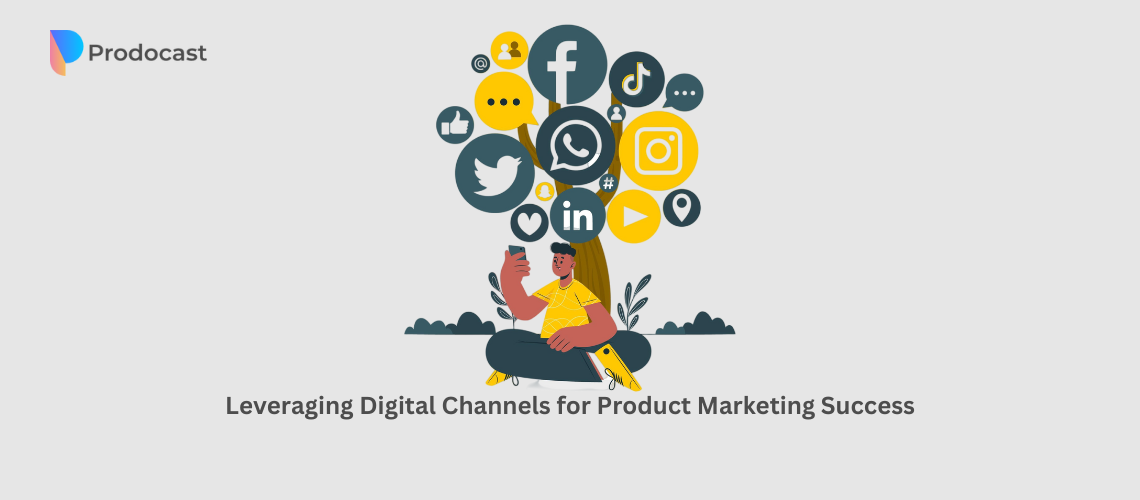Table of Contents
- Understanding Digital Channels
- Building a Strong Online Presence
- Effective Content Marketing
- Harnessing the Power of Email Marketing
- Leveraging Social Media for Engagement
- Measuring and Analyzing Results
- Conclusion
1. Understanding Digital Channels
What Are Digital Channels?
Digital channels refer to the platforms and mediums businesses use to promote products and engage with customers online. These include social media networks, email, websites, content marketing, paid advertising, and more. Each of these channels has unique benefits and challenges, and understanding how to use them effectively is the key to a successful product marketing strategy.
Key Digital Channels for Product Marketing
Let’s take a closer look at the most widely used digital channels:
- Social Media: Platforms like Facebook, Instagram, LinkedIn, Twitter, and Pinterest allow brands to connect directly with users. Each platform offers different ways to engage, whether through posts, ads, stories, or live streams. Social media is ideal for creating buzz, building brand identity, and maintaining customer relationships, but it demands regular content creation and interaction to stay relevant.
- Email Marketing: One of the most effective digital channels, email marketing allows for direct communication with customers and prospects. With an ROI of $42 for every dollar spent, it remains a favorite among marketers. Its main challenge is delivering messages that capture attention in crowded inboxes.
- Content Marketing: Creating and distributing valuable content, such as blog posts, videos, infographics, and eBooks, helps build trust with your audience and positions your brand as an authority in the industry. Content marketing is a long-term investment that requires consistent effort, but the rewards are lasting in terms of SEO and organic traffic.
- Paid Advertising: Pay-per-click (PPC) campaigns, Google Ads, and social media ads allow you to target specific audiences with precision. This channel works well for reaching potential customers quickly, but its costs can escalate if not managed effectively.
Strengths and Weaknesses of Digital Channels for Product Marketing
| Channel | Strengths | Weaknesses |
|---|---|---|
| Social Media | Direct engagement with customers, viral potential, brand building | Time-consuming, requires constant content creation and interaction |
| Email Marketing | Personalized content, high ROI, measurable results | Potential for email fatigue, requires effective list management |
| Content Marketing | SEO benefits, builds authority, long-term value | Time-intensive, requires consistency and quality |
| Paid Advertising | Quick reach, targeted campaigns | Costly, requires ongoing management |
Why a Cohesive Digital Strategy Matters
A cohesive digital marketing strategy is crucial for product marketers to ensure that their messaging is consistent across all channels. Fragmented campaigns or misaligned messages across platforms can confuse customers and weaken your brand’s impact. It’s essential to create a unified experience that guides customers through their journey, from awareness to consideration, purchase, and beyond.
For example, if a potential customer discovers your product via a social media ad, they should find the same messaging and branding on your website, in your email communications, and throughout your content. This consistency builds trust and reinforces the value of your product.
2. Building a Strong Online Presence
Your online presence is your digital storefront. Without a strong presence, even the best products can go unnoticed. A strategic approach to branding, website optimization, and community building is key.
Creating a Compelling Brand Identity
Your brand identity is the image your company presents to the world. This includes your logo, color schemes, typography, voice, and overall visual aesthetic. To create a compelling brand identity, consider the following:
- Understand Your Audience: Your brand should reflect what matters to your target customers. For example, a company that sells eco-friendly products might focus on sustainability in its branding, using natural colors and language that emphasizes environmental responsibility.
- Define Your Brand Values: What does your brand stand for? Clearly defining your core values helps build an emotional connection with customers. Whether it’s innovation, reliability, or customer-centricity, make sure your values are evident in every aspect of your brand.
- Consistency Across Platforms: Every touchpoint, from your website to your social media profiles and email communications, should be consistent in design and tone. This reinforces brand recognition and builds trust with your audience.
Optimizing Your Website for Search Engines (SEO)
Your website is often the first interaction potential customers have with your brand, and ensuring it ranks highly on search engines is crucial. Search engine optimization (SEO) helps your site appear on search engine results pages (SERPs), driving organic traffic.
Key SEO best practices include:
- Keyword Research: Identify the keywords and phrases your target audience is searching for and incorporate them into your content, meta tags, and headers.
- On-Page SEO: Ensure that your website is optimized for search engines with proper header tags, meta descriptions, image alt texts, and structured data.
- Technical SEO: Improve site speed, mobile-friendliness, and user experience to help search engines crawl and index your site more effectively.
- Content Optimization: Write high-quality, informative, and engaging content that answers users’ questions. Google rewards sites that provide valuable information, so ensure your content is tailored to the needs of your audience.
Leveraging Social Media Platforms
Social media is one of the most powerful tools for building brand awareness and engaging with customers. However, not all platforms are created equal. Understanding the demographics and behaviors of users on different platforms is critical for success.
- Facebook: Best for B2C companies and community building, Facebook’s large user base makes it ideal for broad engagement.
- Instagram: Perfect for visually-driven brands, Instagram is a go-to platform for influencers, fashion, food, and lifestyle brands.
- LinkedIn: Best for B2B marketing, LinkedIn helps establish authority and connect with industry professionals.
- Twitter: Useful for brands looking to engage in real-time conversations and customer service interactions.
Building a Loyal Online Community
Building an engaged and loyal online community can amplify your product marketing efforts. Here’s how to create a community around your brand:
- Encourage User-Generated Content: Create campaigns that encourage your customers to share their experiences with your product. This not only increases engagement but also provides authentic content for your brand.
- Start Conversations: Don’t just post content—engage with your audience. Ask questions, start discussions, and show that you value your customers’ opinions.
- Reward Loyalty: Offering exclusive content, discounts, or early access to products for your most loyal customers can build a stronger community and incentivize others to engage.
3. Effective Content Marketing
In digital marketing, content is king. High-quality content serves to educate, entertain, and engage your audience, while positioning your brand as a leader in your industry.
Developing High-Quality Content
To create content that resonates with your audience, focus on the following types:
- Blog Posts: Regularly updating your blog with fresh, relevant content helps drive organic traffic through SEO while providing value to your audience.
- Videos: Videos are increasingly popular as they provide an engaging way to convey information. Consider producing product demos, explainer videos, or customer testimonials.
- Infographics: These are perfect for presenting complex information in a visually appealing and easy-to-understand format.
- EBooks and White Papers: Long-form content that dives deep into a topic establishes your brand as an authority and is a great tool for lead generation.
Creating a Content Calendar
Consistency is key when it comes to content marketing. A content calendar helps you organize your efforts and ensures that you’re regularly producing and distributing valuable content. When creating a calendar, consider the following:
- Content Themes: Plan content around specific themes or campaigns to keep your messaging focused.
- Posting Frequency: Determine how often you’ll publish content based on your audience’s preferences and your capacity to produce high-quality material.
- Promotion Schedule: Plan how and when you’ll promote content across different channels (social media, email newsletters, etc.).
Promoting Content Effectively
Creating great content is only half the battle; you also need to promote it. Effective content promotion includes:
- Social Media Sharing: Share your blog posts, videos, and infographics across your social media channels to reach a broader audience.
- Email Newsletters: Use email marketing to share new content with your subscribers. Personalized content recommendations can boost engagement.
- Collaborations: Partner with influencers, other businesses, or industry experts to increase the visibility of your content.
4. Harnessing the Power of Email Marketing
Email marketing remains one of the most effective digital channels, especially for product marketing. It allows you to reach customers directly with targeted messaging.
Building an Engaged Email List
A successful email campaign starts with a strong, engaged list of subscribers. To build your list, consider the following tactics:
- Lead Magnets: Offer valuable resources such as free eBooks, templates, or product trials in exchange for email sign-ups.
- Opt-In Forms: Place opt-in forms prominently on your website, especially on high-traffic pages.
- Segment Your Audience: Segmenting your email list allows you to send personalized messages based on user behavior, preferences, and demographics.
Creating Personalized Email Campaigns
Personalization is critical to the success of email marketing. Here’s how to tailor your campaigns:
- Dynamic Content: Use personalized greetings, recommendations, and dynamic content to make your emails more relevant to the recipient.
- Behavioral Triggers: Send emails based on user actions, such as abandoned cart reminders, post-purchase follow-ups, or special offers for long-time customers.
Tracking Email Performance Metrics
To refine your email campaigns, track key performance indicators (KPIs):
- Open Rates: How many people opened your email? This metric helps you assess the effectiveness of your subject lines and timing.
- Click-Through Rates: Track the number of recipients who clicked on links in your email. This indicates how engaging your content is.
- Conversion Rates: Measure how many email recipients completed a desired action, such as purchasing a product or signing up for a webinar.
5. Leveraging Social Media for Engagement
Social media is a powerful tool for building relationships and driving product awareness. However, it requires a strategic approach to ensure success.
Identifying Your Target Audience on Social Media
Each social media platform attracts different demographics, and it’s essential to know where your audience spends their time. Use tools like Facebook Audience Insights, Instagram Analytics, or LinkedIn demographics to understand your audience’s preferences and behaviors.
Creating Shareable Content
For content to spread organically, it needs to be shareable. Focus on the following to encourage sharing:
- Visually Appealing Content: Posts with images, videos, or infographics are more likely to be shared than text-only posts.
- Value-Driven Content: Offer something valuable, such as tips, how-to guides, or exclusive deals, that followers will want to share with their network.
- Emotional Appeal: Content that elicits emotions—whether it’s humor, inspiration, or excitement—tends to be more shareable.
Using Social Media Advertising for Targeted Reach
Paid social media ads allow you to target specific demographics and behaviors with precision. Whether you’re promoting a new product launch or a limited-time offer, paid ads can expand your reach beyond your organic followers. Key considerations for effective ads include:
- Targeting Options: Use platforms like Facebook Ads Manager or LinkedIn Ads to target users based on age, location, job title, interests, and more.
- Retargeting: Retarget users who have visited your website or engaged with your content to encourage them to return and take action.
Engaging with Followers Through Comments and Direct Messages
Social media isn’t just for broadcasting messages—it’s for conversations. Engaging with your audience by responding to comments, answering questions, and even starting conversations through direct messages is crucial for building relationships. Active engagement can build trust, loyalty, and a sense of community around your brand.
6. Measuring and Analyzing Results
To ensure your digital marketing efforts are driving success, you must continuously measure and analyze your results.
Key Performance Indicators (KPIs) for Product Marketing
KPIs help you evaluate the effectiveness of your digital marketing campaigns. Key KPIs to track include:
- Website Traffic: Track the number of visitors to your site and identify which channels are driving the most traffic.
- Conversion Rates: Measure the percentage of visitors who take a desired action, such as signing up for an email list or making a purchase.
- Engagement Metrics: On social media, track likes, shares, comments, and direct messages to assess how engaged your audience is with your content.
- Email Metrics: Monitor open rates, click-through rates, and unsubscribe rates to determine the effectiveness of your email campaigns.
Using Analytics Tools to Track Performance
Analytics tools provide valuable data that can guide your digital strategy:
- Google Analytics: Track website traffic, user behavior, and conversion rates to gain insights into how visitors interact with your site.
- Social Media Insights: Use built-in tools like Facebook Insights, Instagram Analytics, and Twitter Analytics to track engagement and audience growth.
- Email Marketing Analytics: Platforms like Mailchimp or HubSpot provide detailed email metrics to help you understand how your campaigns are performing.
Making Data-Driven Decisions
Once you’ve collected data, the next step is to use it to improve your digital marketing efforts. Analyze what’s working and what isn’t, and adjust your strategy accordingly. This might involve tweaking your messaging, changing your target audience, or shifting focus to channels that are delivering the best results.
Closing Thoughts
In today’s digital-first world, leveraging the right digital channels for product marketing success is critical for any business. A cohesive strategy that integrates social media, email marketing, content marketing, and SEO will help you build a strong online presence, engage with your audience, and drive conversions. By continuously measuring and analyzing your efforts, you can refine your approach to ensure long-term success. With the right mix of digital tools and tactics, you’ll be well on your way to achieving your product marketing goals.
Bonus Tip: Promote Your Software on Prodocast
If you’re a software developer or vendor looking to expand your product’s reach, listing it on Prodocast is an excellent way to gain visibility. Prodocast allows you to list your software products for free, providing a platform to connect with potential customers and showcase your offerings to a wider audience. By leveraging digital channels and utilizing platforms like Prodocast, you can maximize your product marketing efforts and drive more traffic to your software.



